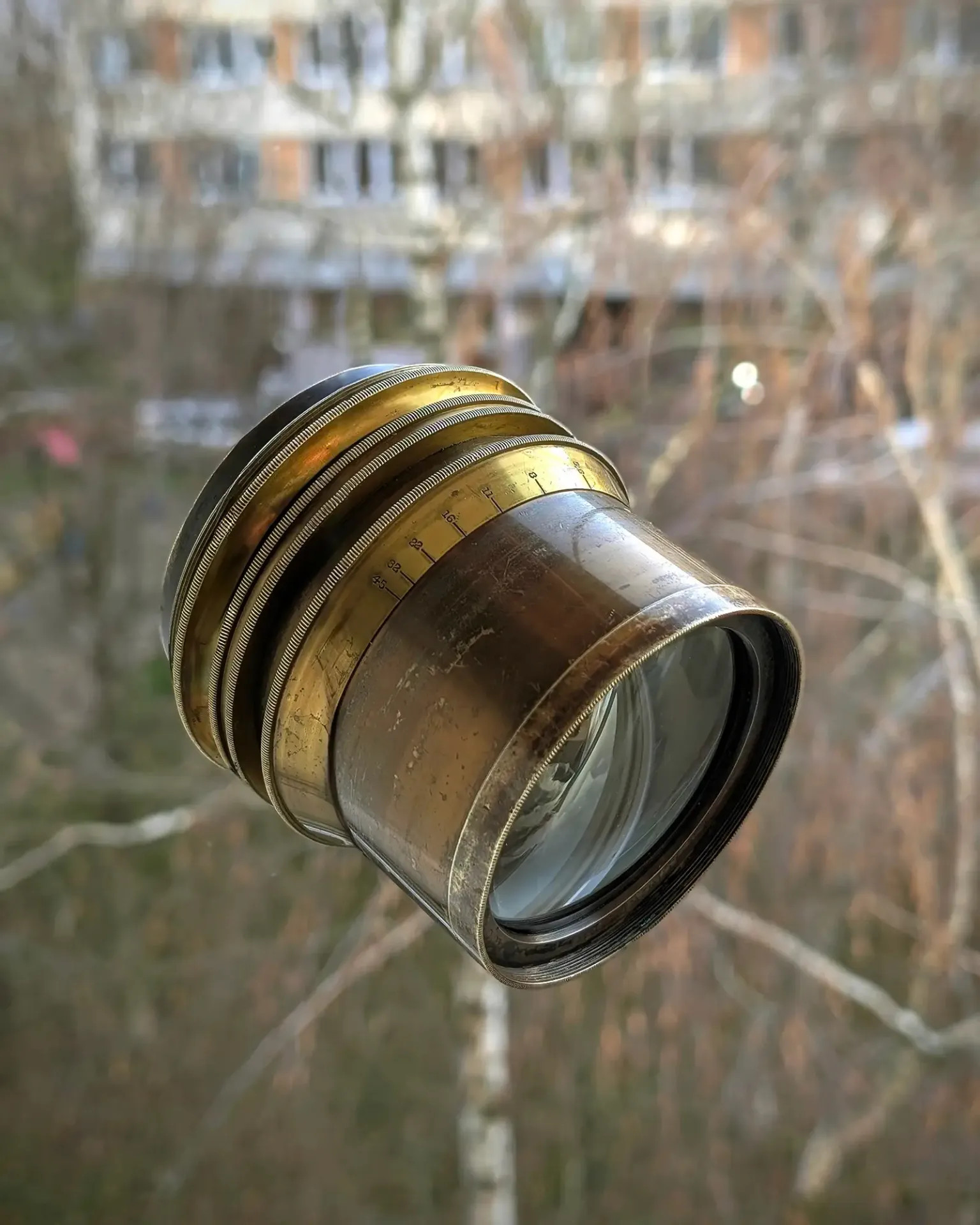#9 Crown Anastigmat 300mm f4.5
Christmas time is a season of miracles and once in a while such wonders occur even in photography. While a burning camera didn’t appear to me, something equally remarkable occurred – the resurrection of a lens and its return from the brass Limbo.

It's almost become a mantra to kick off my articles with lines like, "The only lens in the universe", "A ridiculously rare contraption", or "Rarer than hen's teeth." What can I say? I wallow in the extraordinary, feeding the illusion of my own uniqueness. Enough excuses, though - let's dive into today's lens. A piece so outrageously rare that even a careless lover of New Year's firecrackers could count them on one hand. Presenting the completely unknown soft-focus Crown Anastigmat Series I 300mm f/4.5.
Once upon a time there was a company called Crown Optical Co. Rochester N.Y. (not to be confused with Crown Optical Co. Ltd. of Japan!). They were based in Rochester, once the Mecca of American optics. It housed giants like Bausch & Lomb and Kodak, along with a myriad of smaller manufacturers.
Crown fell into the category of small, short-lived companies. A. H. Hatmaker founded it in 1906 with his secretary A. E. May, only to have it swallowed by the U.S. government in 1917 and folded into the Naval Gun Factory. For two years they devoted themselves entirely to the war effort - and by 1919, Crown was gone.
Out of the entire thirteen years of the factory's existence, a large part was devoted to the production of army binoculars and periscopes. Eleven, actually, because for the last two years NGF no longer produced even them. Almost nothing is known about the company, its portfolio, and especially the Series I line. There are no surviving serial-number records, so estimating production is a shot in the dark. Given the size of the business, its mayfly lifespan and the even shorter run of photographic optics, I'd wager only a few thousand lenses total. The entire Series I? Maybe a few hundred. This specific Series I 300mm f4.5? At best a few dozen, maybe not even that.
Soft-focus lenses never were and never will be at the center of attention, nor the main production pillar of any company. Throughout history, they've been a niche curiosity - and in the version with adjustable internal movement (Universal Heliar, TTH Cooke, etc.), hellishly difficult to make. Just like in-house calibers or a tourbillon in watchmaking, or the Austrian Sacher, these are sophisticated solutions demanding extreme know-how. Which makes it all the more remarkable that such a tiny factory, with such a short lifespan and not even fully dedicated to lens production, managed to develop exactly this kind of piece. It's of course possible Crown rebranded the design and licensed it from another maker, but a) I doubt they had the money or a reason to do so, and b) I don't know of any other SF lens of these specs and looks. And I know them all!
- The lens allows adjustment of the soft-focus effect via a separate ring, ranging from levels 1 to 4. Changing it shifts part of the optical system back and forth, slightly altering focal length while controlling diffraction and thus the softness of the image. This represents the pinnacle of optical engineering, achieved by only a few manufacturers, earning it a reputation as "nobility" among lenses. You can read about other methods of regulation and SF in general in my previous article.
- It was also a hot novelty back then: the anastigmat. An optical scheme with very well-corrected spherical aberration, astigmatism, and coma. Designed in 1890 by Dr. Paul Rudolph, its first two decades were more of an experimental phase. Crown's achievement is therefore doubly impressive.
So what about that promised resurrection? Here's the story: the lens arrived to me from faraway lands in a frightfully dilapidated state. The SF mechanism and aperture were fortunately relatively intact, but the most crucial part, the heart of the lens - the glass itself - was hopelessly separated. I did take some photos with it, and the results looked far better than one might expect from its outward appearance. Even so, it pained me to let something so rare suffer such a sad fate, so I began pondering what could be done.
- In this context, separation refers to the breakdown of the cement layer that bonds the optical elements together. Manufacturing flaws, improper storage, a fall or who knows what else can trigger separation. It manifests in various ways, but the common symptoms are a loss of contrast, sharpness, and an increased susceptibility to stray light. The cure is singular: remove the old "glue" and re-cement the lens.
- Back then, the glue was so-called Canadian balsam. This mixture of resin from the balsam fir (Pinus balsamea) and xylene in a 1:1 ratio creates a substance with a refractive index almost identical to quartz glass. Once cured with heat, this concoction becomes clear and bonds the optical elements together without negatively impacting image quality.
- Separation usually starts at the edge and mostly stays there. It's often yellow to orange, with a cracked look, and in extreme cases it can cover most of the surface. With more modern lenses that feature coatings, separation often shows up as multi-colored rainbow effects that, while visually intriguing, are still undesirable. A special case are "flowers": tiny dust grains trapped during cementing, around which separation slowly spreads like petals. Since no air = no oxidation, these spots remain clear and are kind of pretty - but still a pain in the ass.
The theory of re-cementing was familiar to me, but it's much easier said than done. Just getting your hands on Canada balsam isn't exactly a walk in the park (and playing around with xylene at home is even less so). On the internet you'll find plenty of guaranteed guides on removing old adhesive by gently baking the lens in an oven (where you'll also bake the new adhesive in place) or slowly heating it in a pot of water. What these guides often leave out, however, is that you're running a high risk of thermal shock and irreparable cracking of the fragile, old glass.
- The whole concept of "cooking" lenses reminded me of the time I, blissfully unaware, stumbled across a surprisingly detailed online recipe for making homemade napalm. At least that one mentioned that boiling a pot of gasoline on your stovetop might be somewhat precarious - and might just blow up your house. And before you ask, no, I don't remember where I found that recipe. Probably somewhere in old family cookbook.

And how do you ensure that the elements are reassembled exactly as they were before? Easy - just mark them with a pencil, right? Wrong. Once again, no one tells you that the lenses need to be calibrated in both axes, X and Y. For that, you need an optical calibration bench, which - unlike a napalm saucepan - isn't exactly standard household equipment. If you skip this step, you risk misaligning the optical system and affecting the lens's performance. Maybe the shift will be so minor that no one notices. Or maybe not. For a standard, inexpensive Tessar or Rectilinear lens worth a few money, experimenting and sniffing xylene fumes might be justifiable. But in this case, it was too much responsibility for me.
- I know my limits, and since I wasn't blessed with advanced knowledge of optics, I entrusted the entire project to a professional. The details are probably a closely guarded family secret, but the lenses are separated using acetone mixtures, and instead of the long-outdated Canada balsam, they're re-cemented using special polymer adhesives or UV-cured glues. These modern materials offer superior optical properties and are far less prone to degradation over time. However, the process is reversible only with significant difficulty - or not at all.
The Crown lens consists of four cemented elements. And OF COURSE, EVERY SINGLE ONE OF THEM HAD TO BE REPAIRED. Sorry for yelling, but the odds of something like that are almost negative. Naturally, this kind of fun isn't cheap. I hemmed and hawed for a long time but ultimately gave in - just as Dante fetched Virgil from Limbo for one more journey, I decided to dragged the Crown from the clutches of obscurity and grant it new adventures. You can see its resurrection compared in the photos below.
And now the most important question: how does it shoot? The SF scale runs from 1 to 4, with level 1 being the sharpest option, free of any soft or overexposed areas. Level 4 is the maximum softness, and it's quite fascinating that even with a significant aperture stop-down, the SF effect remains easily visible - usually, such effects disappear irretrievably around f8. Overall, the effect is subtler compared to hardcore (softcore, hm?) pictorialist lenses, so don't expect anything as extreme as a wide-open Kodak Portrait. I'd liken it more to the Bausch & Lomb Portrait Unar (yes, there will be an article on that too!) and similar SF portrait lenses. That's not a bad thing - on the contrary, it makes it well-suited for portraits where you want to add just the right touch of love and softness.
Taken together, its versatility and small size (compare it to a Universal Heliar 300mm f4.5 or a Cooke, ha!) make it a surprisingly practical lens. Unfortunately, the photos below aren't as illustrative as I'd like them to be. First, they were all taken with the SF set to 1 because the ones with stronger settings didn't turn out as I'd hoped, and I wasn't about to embarrass myself. Second, these were taken before the repair. That means reduced contrast (though that's tricky - SF lenses are inherently less contrasty, so it's hard to pinpoint what's a feature versus a defect), increased sensitivity to side light and backlight, and no direct before-and-after comparison. A proper comparison will follow later, and I'll update it here. I hope you, dear reader, will understand and forgive my impatience - the urge to write this article outweighed my ability to wait.
As the year draws to a close, I hope you're planning to dedicate the next one to shooting even more photos on the largest formats possible. I'll leave you with a phrase that applies equally to the Crown, myself, and you: "Lazarus! Rise and shoot!"